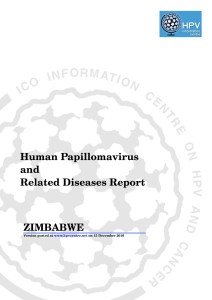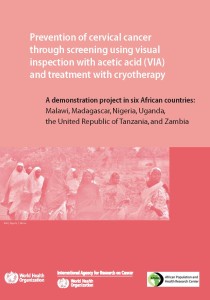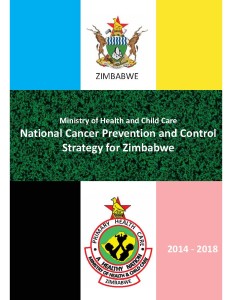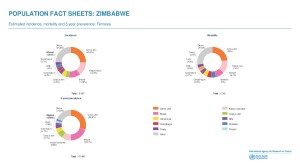Hi, Everyone –
I recently received 10 questions about cervical cancer in Zimbabwe from Rumbi Chakamba, a reporter for an online news service called News Deeply – Women and Girls Hub. Reporters play an important role in educating the public about cancer and other health concerns, and I answered the questions carefully. I thought they might also be helpful to others, so I’ve posted them below.
Note: I have added additional comments in some cases. I’ve enclosed these in [brackets].
I welcome your comments on my replies. My thanks to Rumbi Chakamba for the opportunity to answer these questions.
31 January 2017 – Read the News Deeply – Women & Girls story by Rumbi Chakamba here:
Rumbi Chakamba’s questions
- Can you give us an overview of the disease burden in Zimbabwe?
- Why is this so high?
- Is your organisation involved in any programs aimed at early detection, treatment and education?
- Would you say such programs have been effective?
- What challenges do you face when tackling the problem of cervical cancer?
- Which health facilities currently offer cervical cancer screening and treatment services?
- Are such services easily available to all women especially those in the rural areas?
- Would you say enough is being done to educate women on cervical cancer?
- What more should be done to tackle the disease?
- Is there any other information you would like our readers to know?
[Cervical cancer is nearly always caused by the human papilloma virus (HPV).] Here are some important facts about HPV from the WHO fact sheet (http://www.who.int/mediacentre/factsheets/fs380/en/):
- Human papillomavirus (HPV) is a group of viruses that are extremely common worldwide.
- There are more than 100 types of HPV, of which at least 13 are cancer-causing (also known as high risk type).
- HPV is mainly transmitted through sexual contact and most people are infected with HPV shortly after the onset of sexual activity.
- Cervical cancer is caused by sexually acquired infection with certain types of HPV.
- Two HPV types (16 and 18) cause 70% of cervical cancers and precancerous cervical lesions.
- There is also evidence linking HPV with cancers of the anus, vulva, vagina and penis.
- Cervical cancer is the second most common cancer in women living in less developed regions with an estimated 445 000 new cases in 2012 (84% of the new cases worldwide).
[Note: cervical cancer is the number 1 cause of cancer and of cancer death among women in Zimbabwe.] - In 2012, approximately 270 000 women died from cervical cancer; more than 85% of these deaths occurring in low- and middle-income countries.
- Vaccines against HPV 16 and 18 have been approved for use in many countries.
Here are my answers to your questions:
1. Can you give us an overview of the disease burden in Zimbabwe?
Here are the World Health Organization statistics for cervical cancer in Zimbabwe:
About 2,270 new cervical cancer cases are diagnosed annually in Zimbabwe and 1,451 women are estimated to die of cervical cancer annually
These estimates are for 2012, the latest figures available.
Cervical cancer ranks as the 1st leading cause of female cancer in Zimbabwe (this is when considering women of all ages). It accounts for 25% of all cancer cases and about 23% of cancer deaths among women in Zimbabwe.
Cervical cancer is the 2th most common female cancer in women aged 15 to 44 years in Zimbabwe.
View the fact sheet from the International Agency for Research on Cancer (a WHO agency) here or see it online: fact sheet.
2. Why is this so high?
Cervical cancer is caused by human papilloma virus (HPV) infection. HPV is a common infection among both men and women.
But only some women who become infected with HPV develop cervical cancer. In most cases, the immune system clears HPV infection from the body, and the woman (or man) won’t even know it was there. Unfortunately, sometimes HPV is not cleared by the immune system, and over a period of time cancer develops on the cervix. It’s not completely understood how this happens, but it’s believe that other factors, co-factors, are necessary to help the process. Those cofactors include the following (see the attached HPV and Related Diseases Report, chapter 5): 
- Tobacco smoking
- Having multiple children
- Long-term use [five years or more] of hormonal contraceptives [is associated with an increased risk of cervical cancer. When a woman stops taking hormonal contraceptives, the risk gradually declines.] See the U.S. National Cancer Institute article Oral Contraceptives and Cancer Risk.
- HIV infection
HIV infection is perhaps the most serious and known cofactor because it damages and eventually destroys the immune system. This leaves the body far less able to control HPV.
- Are there any programs that your organisation is involved aimed at early detection, treatment and education?
The Zimbabwe Ministry of Health has established a national cervical cancer prevention program that provides screening of women for precancerous changes on the cervix. The screening method they use is called visual inspection with acetic acid and cervicography (VIAC). It involves swabbing the cervix with a vinegar-like solution. If precancerous cells are present on the cervix, they turn white. “Cervicography,” the “C” in VIAC, refers to the use of a camera to photograph the appearance of the cervix during screening. The photo is used as part of the woman’s medical record and for quality control, and to help judge changes when the woman returns for follow-up screening in three years. (Sometimes the “C” is said to refer to “camera.”)
The cells can be removed using one of several techniques, and one often used is to freeze them, a method called cryotherapy. Killing or removing these precancerous cells prevents them from progressing to cervical cancer.
Our organization, Better Healthcare for Africa (BHA), working with Dr Lowell Schnipper, an oncologist at Beth Israel Deaconess Medical Center and Harvard Medical School in the U.S.A., supports a VIAC program at St. Albert’s Mission Hospital and at Karanda Mission Hospital. BHA also helps these hospitals provide community cancer awareness and education programs.
BHA also has educational articles on its website, such as VIAC and How it Works
For HIV-positive women: they should take antiretroviral drugs regularly as prescribed. This will help keep their immune system strong. The immune system is important for controlling HPV in the body (for most women, the immune system eliminates an HPV infection). The immune system also plays an important role controlling cancer.
- Would you say such programs have been effective?
Yes, VIA screening programs have been effective. This screening method is endorsed by the World Health Organization for low-resource countries [read the WHO report here or click on the image], and they have been used in India and studies have shown that they reduce the incidence of cervical cancer.

Prevention of Cervical Cancer Through Screening Using Visual Inspection With Acetic Acid and Treatment with Cryotherapy: A Demonstration Project in Six African Countries
VIAC screening further contributes to women’s health because it finds noncancerous conditions such as schistosomasis infection or cervicitis, an inflammation of the cervix that can have several causes but is important to treat. For example, cervicitis might make a woman more susceptible to infection by HIV.
5. What challenges do you face when tackling the problem of cervical cancer?
There are several challenges when tackling the problem of cervical cancer:
- VIAC screening also identifies women who have cervical cancer, and few treatment options are available for these women. Drugs to control pain (an area of medicine called palliative care) for women and men with advanced cancer or other chronic diseases are often in short supply in Zimbabwe, including morphine.
- The most effective way to prevent cervical cancer is by using the HPV vaccine. The vaccine is most effective when given to girl and boy children age 12, before they become sexually active, but it can also help women into their 20s, also.
- It would be helpful if women in Zimbabwe could be tested for the presence of HPV. It involves taking a swab of cervical cells and sending them off to be analyzed for the presence of HPV DNA. If the test is negative, it means the women is not infected with HPV and does not require VIAC screening. (She should consider retesting or VIAC screening in three years.) If the woman does test positive, she does have an HPV infection and should be followed by VIAC.
- Which health facilities currently offer cervical cancer screening and treatment services?
I believe all government hospitals offer VIAC screening, though there may be exceptions due to economic circumstances. Screening is also available at St Albert’s and Karanda Mission Hospitals. I do not know if it is offered at other mission hospitals.
7. Are such services easily available to all women especially those in the rural areas?
I think the Ministry of Health and Child Care is trying to make VIAC screening widely available but the Ministry is constrained by the nation’s economic challenges. NGOs such as BHA are contributing as they can.
- Would you say enough is being done to educate women on cervical cancer?
Cancer education of women – and of men, teens and young adults — is an ongoing task. Community education is critical to encourage women to get screened. It is also important for eliminating stigma. Stigma and shame can prevent women from seeking screening and treatment early, when cancer is most readily and successfully treated and sometimes cured, and when care is less costly.
Stigma can also prevent a woman from going to a doctor after she finds a change in one of her breasts, a lump or change in shape.
Local beliefs that a woman is less of a person because surgery has removed her uterus or a breast is another form of stigma that must be countered. Coping with cancer is difficult enough without additional suffering inflicted by ridicule, shame or embarrassment.
Perhaps such attitudes could be changed or softened in rural areas using dramas to education people and instill greater empathy, compassion, kindness and support to the woman and her family. (Empathy, compassion, kindness and support are especially needed if cervical cancer causes a woman to develop a vaginal fistula and the woman is shunned or isolated.)
Cancer is a complex disease, and the better that people understand what it is and why it happens, the more likely they may be to take steps to prevent it. How cancer education is done, how often and where it happens and how well it is done are often a question of resources (money) and priority. The better people understand cancer and how it is diagnosed, treated and prevented, the more likely they may be to give it a higher budgetary priority. (So articles like yours are very important.)
9. What more should be done to tackle the disease?
See my replies to questions 5 and 8. And perhaps writing more stories like this one to educate people about cancer and the importance of compassion and emotional support for the person with cancer and her or his family.
[The “National Cancer Prevention and Control Strategy for Zimbabwe 2014-2018” is a publication of the Zimbabwe Ministry of Health and Child Care’s Epidemiology & Disease Control Noncommunicable Diseases Unit. It provides a frank and realistic assessment of cancer prevention and patient management in Zimbabwe. It is well written and well organized, and I recommend it to anyone interested in cancer care and control in Zimbabwe. I find it another reminder that, in spite of all the difficulties and challenges facing Zimbabwe, there are good people who are struggling with limited resources to reduce suffering and improve healthcare in the nation. View the strategy here or click on the image.]
10. Is there any other information you would like our readers to know?
I would again encourage everyone to work to end the stigma of cancer, particularly cervical, breast and uterine cancers. A woman may notice a change in her body or a flow of blood that frightens her and may make her believe she has cervical or uterine cancer, or she might feel a change in her breast, but stigma within the family or her community may keep her from going to the doctor until the disease becomes far more serious.
Last, I work at The Ohio State University Comprehensive Cancer Center – James Cancer Hospital and Solove Research Institute, which offers a free online course about the science of cancer called Introduction to the Science of Cancer. It is available on iTune U to anyone with an internet connection. Go to go.osu.edu/scienceofcancer. To access the course, you will need a free Apple ID and the free iTunes app on your computer, tablet or phone.
[A final note: By following the evidence-based guidelines to prevent cancer, a person can also lower his or her risk of other serious illnesses such as heart disease, hypertension, diabetes and obesity. The efforts we make to prevent cancer can benefit us in many ways.]
Keep well, everyone…Darrell
3 thoughts on “Cervical Cancer in Zimbabwe Q & A”
Comments are closed.


i think most women still lack facts on cervical cancer….education is needed
educate women cz mos of us lack the rightful facts
Thank you, Ms.Tom – Yes, many women — and men! — lack facts on cervical cancer. It is a very preventable cancer if caught early. VIAC screening can catch changes on the cervix before they become cancerous and those changed cells can be removed. Their removal will likely prevent the cancer.
Thank you for writing and keep well…Darrell